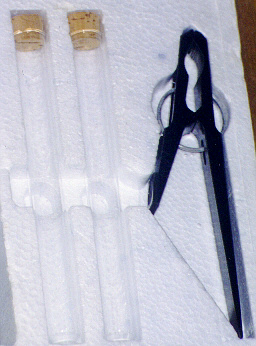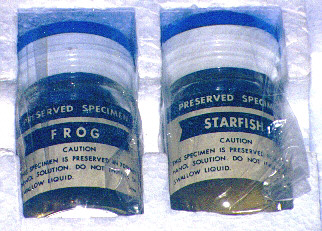In 1965 I was saving some money
to buy a Tasco 300x microscope that came in a nice wooden box
with 4 slides, only one of the slides was prepared. I
eventually bought this set and it became one of my first
microscopes. The set that I am describing here (see Fig. 1)
was way beyond the means of a 12 year old but that did not
stop me from spending time looking at it in the display case
at the photo shop that used to retail these sets. Eventually
32 years had to pass by and in 1997 I found the set in mint
condition even with the original wrappers still covering the
Styrofoam compartments. It remains the jewel in my small
collection of microscopes built for kids in the middle of the
20th century. I don't like to call them toy microscopes
because by today's standards many of these microscopes
perform much better than a toy. So I have decided to call
them student microscopes.
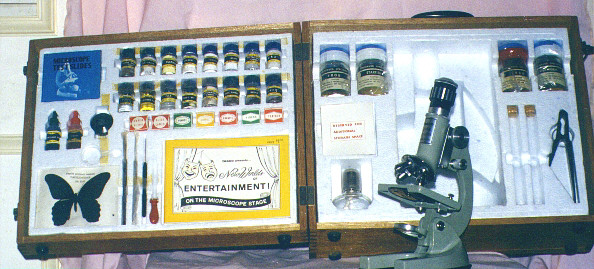
Figure 1
The set that is presented here is the Tasco #960 set. As you can see in the photo (Figure 1), it consists of one metal microscope with a zoom ocular and powers that go from 50 to 1200x. The microscope itself is about 11 inches tall, solid and well engineered (see Figure 2). It has a substage diaphragm to control the light and one of the positions of the diaphragm contains a polarizing filter to be used in combination with the ocular polarizer which is also included in the set. The microscope also has a fine focusing screw and an adjustable stop to avoid breaking cover glasses with the high power objectives. The ocular has 10x and 15x positions available through the rotation of the knurled area around it. This zoom characteristic brings the highest power attainable to 1200x.
The quality of the optics is
very good as compared to those of my professional vintage
1940s Bausch & Lomb microscope. In addition the field of
view is the widest that I have seen in this type of
microscope. The optics are easily removed for cleaning. This
is a common characteristic in all of the Tasco microscopes
from the era and provides for the necessary maintenance to
keep the microscopes in good working order. All of the optics
are of good quality glass. It is interesting to point out
that this microscope is one of the very few in the Tasco line
from this period that does not include a combination of
substage mirror/electric light. Being probably that it was
the top set in its type, I consider that this microscope was
the transition between the student and professional
microscopes available at the time from Tasco. Interestingly
the only other microscope in the line without the substage
light was the smaller 300x microscope mentioned above. It was
also the more economical model.
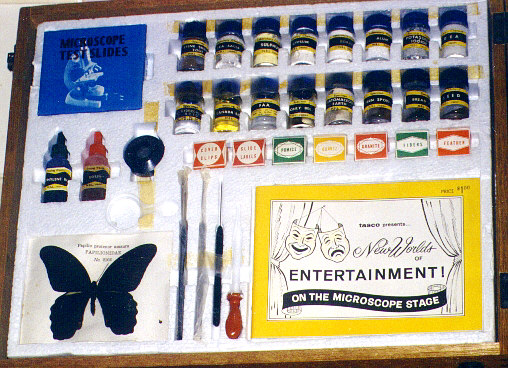
Figure 2
In addition to the microscope the set includes a mini microscopy lab (see Figure 3). An inventory of this mini lab shows a box of slides, some of them prepared, cover slides, two test tubes and a combination cover slide/test tube holder (see Figure 3a), a complete dissecting set, dissecting board, magnifier, a large number of small vials containing biological stains, shrimp eggs, fern spores, diverse salts etc. There are also four preserved specimens, a crab, frog, caterpillar and a sea star (see Figure 3b). A desiccated butterfly is also included. You can also see the alcohol lamp and specimen-collecting bottle (Figure 3).
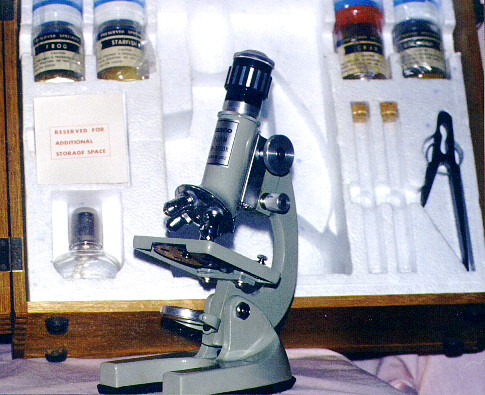
Figure 3
This is a complete microscope
set designed for many hours of learning. You were even
supposed to dissect and prepare tissues for permanent slide
preparations with this set. A main complement of the set is
the manual "New Worlds of Entertainment" (see
Figure 2) written by no other than Julian D. Corrington Ph.D.
former chairman of the Department of Biology at the
University of Miami. Dr. Corrington was a well-known US
microscopist who left us with several excellent books
specifically written for amateurs and beginners in
microscopy. This manual contains enough information to keep
you occupied with the set for a very long time. It also
leaves open to your own imagination many other experiments
that you may design and perform on your own with this
microscope.
Figure 3a |
Figure 3b |
Sets like this one will never be available again and the reason is simple. The animals in the set are preserved in methanol and there are other substances in the set that are now considered hazardous. Of course, common sense dictated that the set should be used by older kids with adult supervision. This set had enough activities to awaken a long term interest in science and specifically microscopy. It is a small self contained microscopy laboratory unequal to anything being produced today or even in its own time.
A tip for those who collect this type of microscope: The hazy look that you often see when you look through them is due to a very inconspicuous film that develops over the lenses and is easily cleaned with a 50/50 mixture of 70% alcohol and distilled water plus some cotton swabs. There is no reason to keep one of these microscopes just as a static display. They can be refurbished and cleaned easily to continue providing good images for both kids and adults for years to come. In this specific case and due to its mint condition, this set is being kept mostly for display except for the microscope which sometimes is used for demonstration purposes.
I hope that you have enjoyed the description of this set. I will eventually write on some of the other sets from the same era.
Comments to the author Guido Santacana welcomed.
Editor's note: The author's previous Micscape articles on aspects of toy microscopes are:
